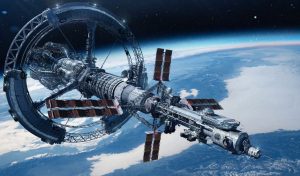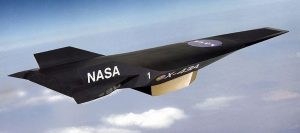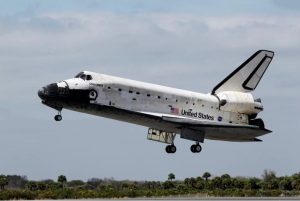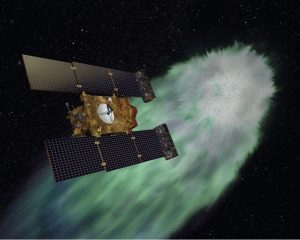The fastest man-made speeds:
You might be curious about the fastest man-made speeds; Here is the list of the fastest man-made speeds we are going to discuss in this paper:
|
|
The list of our content about the fastest man-made speeds |
|
The Discovery |
NASA X-43 |
| Stardust |
The Space Shuttle Columbia |
|
Helios |
Voyager I |
|
Parker Solar Probe |
The manhole cover |

Let’s face it: we’ve all felt the need for speed, but if you imagine the fastest man-made speeds you’ve ever gone, then in all likelihood, you’re only really scratching the surface. While it’s certainly not an invitation to go all Dom Toretto and slam the pedal to the metal, most consumer cars will only reach an average top speed of around 120 miles an hour. Bullets are even faster, with most firing at around 2600 miles per hour; that’s over three times the speed of sound.
But we’ve got tech that can leave even that in the dust. As our technological capabilities advance, humans are constantly discovering new ways to create vehicles and other objects that can travel at even greater speeds than previously thought possible.
What are some of the inventions that go quite literally above and beyond the speed limit? What are the fastest man-made speeds? And how can sleek, speedy sports cars or supersonic fighter jets not even come close to the incredible speeds of the mighty… manhole cover?
Hold on, that can’t be right… wait, that thing went how fast? Before we get to that let’s start at the lower end of the speedometer. Imagine a rocket sled, and no, we certainly wouldn’t recommend using one to slide down a snowy hillside.
While they’re not strictly vehicles themselves, rocket sleds are a test platform commonly used to test how certain experimental objects hold up under extreme acceleration; these include missiles and parts of aircraft.
But if it’s a platform, isn’t a rocket sled fixed in one place? Not! As their name suggests, these sleds are propelled by rockets over a track on sliding pads called slippers as opposed to wheels. The tracks they’re usually situated on can stretch for over 10,000 feet, and tanks full of helium gas help a rocket sled speed along without any friction.
Given the high velocity at which they travel, rocket sled slippers have to curve around the rails beneath them to prevent the sled from flying off the track. They also can’t use wheels as these would either spin off or spin until they came apart, thanks to extreme centrifugal force. In some tests where they’ve been used, rocket sleds have soared well past 6,000 kilometers per hour, with one at the Holloman Air Force Base in New Mexico even reaching just over 7,000 kilometers per hour – or around 4350 miles.
The first of our list of the fastest man-made speeds
NASA X-43

Of course, racing across the ground on rails is one thing, but how about something fast enough to be qualified as not supersonic but hypersonic? Meet the NASA X-43, one of the fastest man-made speeds made ever, and an experimental unmanned aircraft that was created to test out the possibility of hypersonic flight.
Part of NASA’s Hyper X program in the nineties – not to be confused with the brand of RAM in your gaming PC – the X-43 broke several of the previous airspeed records for jet-powered aircraft. Breaking Mach 1 to Mach 5 is considered traveling at supersonic speeds, between 900 and almost 4000 miles per hour, well over the speed of sound.
As a point of comparison, the fastest that a manned aircraft has ever been able to reach is just over Mach 6, piloted by William J. Knight in 1967, traveling at over 4500 miles per hour. How does the X-43 measure up?
Well, it has a top speed of Mach 9.6, around 7000 miles per hour. That’s over nine times the speed of sound! The unmanned jet even had an innovative feature specifically designed to combat the potential problems of traveling at speeds that fast. At Mach speeds, the compression shock waves involved in aerodynamic drag can produce a lot of heat. So much heat in fact that it can get hot enough to melt metal the faster a hypersonic vehicle goes.
So, the X-43 compensated for this by cycling water behind its engine’s cowl and other areas likely to experience the extreme heat, thus cooling it down. Sadly for the X-43, though, despite its ludicrously impressive speeds, the unmanned vehicle was only ever designed for conducting experimental tests, and while it could be controlled throughout its high-speed flight, it was not designed to land and be recovered, instead the test vehicles were destined to crash into the Pacific Ocean once their tests were completed.
The second on our list of the fastest man-made speeds
the Space Shuttle Columbia

7000 miles per hour is nothing to be sniffed at, but that might as well be a rookie number compared to this next big contender. This is the Space Shuttle Columbia, the first successful NASA shuttle to ever reach space in 1981 and the second invention of the fastest man-made speeds we want to talk about.
To reach the height and speed necessary to break through the Earth’s atmosphere, the shuttle needed to be equipped with three main engines and a tank containing over 530,000 gallons of liquid oxygen and liquid hydron, which were mixed and burned as fuel. Over its 27 successful missions, the Columbia reached a maximum speed of 17,000 miles per hour in lower Earth orbit. It was going so fast that it even allowed the crew on board to witness multiple sunrises and sunsets in a single day!
During its 22 years in operation, the shuttle flew on 28 total missions, spending over 300 days in space and completing over 4000 orbits around the Earth. However, the Columbia is perhaps best remembered for the tragedy that occurred during its final mission. On the first of February, 2003, the Space Shuttle Columbia took off to conduct several experiments that needed a low-gravity environment.
However, as the shuttle re-entered Earth’s atmosphere, the seven members of its crew lost control when the Columbia began to burn up during re-entry. The shuttle itself started to break apart, showering debris over parts of southern Texas and Louisiana. The spacecraft’s disintegration claimed the lives of all seven crew members on board before it crashed at speeds well exceeding its normal limits.
Investigations into the cause of the tragic disaster found that a piece of insulating foam from the external propellant tank had broken off less than a minute after take-off. Thanks to the momentum of the shuttle, the loose piece of foam was fast enough to punch a hole in the edge of the left wing, damaging the reinforced carbon insulation tiles designed to protect the shuttle from the extreme heat of re-entering the atmosphere.
When the Columbia returned to Earth, hot gases caused major damage, melting parts of the left wing and causing it to collapse.
Disadvantages of this project:
- Thermal Protection System Weakness
- Insufficient Hazard Analysis
- Lack of Confidence in Predicting Incidents
- Delay in Communication and Decision-Making
- Uncertainty in Repair Quality
You can read more about it here.
The third of our list of the fastest man-made speeds
The Discovery

Next on our list of the fastest man-made speeds is another entry from NASA’s Space Shuttle Program, with the record for the most successful space mission: the Discovery.
Launching on its first mission in 1984, this shuttle completed 39 successful flights, becoming the third orbiter vehicle to reach space after the aforementioned Columbia and the Challenger. The Discovery also holds the highest speed on record for a spacecraft, reaching a whopping 17,500 miles per hour.
That’s over five times faster than the speed of a bullet. The Space Shuttle Discovery consisted, at launch, of three main components. The orbiter itself is the white and black winged craft that you might think of when you first hear the words ‘space shuttle.’ A craft like that can’t reach the upper atmosphere on its own, though, which is why it also requires the help of a single-use central fuel tank and a pair of reusable rocket boosters.
Although, as of its final mission in February of 2011, it has since been retired from active spaceflight, the Discovery remains the oldest orbiter in NASA’s shuttle fleet. It spent the equivalent of an entire year in space, traveling almost 240 million kilometers in that time; or around 150 million miles. That’s also a considerable distance further than the orbiter vehicles that preceded it.
It was responsible for transporting over 180 astronauts into space and returning them back to Earth safely, a number of them making the journey more than once. Since completing practically every type of space mission a shuttle like it can, the Discovery has since been transferred to the Smithsonian as of April 2012, preserved in the same condition it was recovered in after its last flight.
Space Shuttles like the Columbia and Discovery might be capable of speeds fast enough to break through the Earth’s atmosphere and back, but they’re slightly outpaced by Snoopy and Charlie Brown. And no, we’re not talking about the Peanuts characters. These were the callsigns given to the Command and Service Module and the Lunar Module of Apollo 10. You’ve likely heard of Apollo 11, the famous NASA mission that put the first humans on the surface of the Moon.
Well, think of Apollo 10 as the dress rehearsal, the step before the one small step for man and a giant leap for mankind. Apollo 10 was a mission designed to test out the specifics of the lunar landing exactly as they would be carried out during Apollo 11 – apart from the actual landing on the Moon part. The Apollo 10 craft was launched into space on top of a Saturn V rocket, then orbited the Moon as a test run.
The craft itself consisted of a Command Module and a Lunar Module, the latter of which would fly within just over 14 kilometers of the Moon’s surface before the crew performed a planned abort of the mission. Apollo 10 made over thirty successful orbits of the Moon before returning to Earth – which is when it earned its place on this list as one of the fastest man-made objects ever created.
The Lunar Module was too heavy to return to Earth from the Moon’s orbit, but this was by design. The Command Module, ‘Charlie Brown’ as it was known at NASA, was the part that made the journey back. And when it did, on May 26th, 1969, the module was able to achieve a mind-boggling speed of 24,791 miles per hour.
That’s faster than both the Space Shuttles we just mentioned and was even recorded by the Guinness Book of World Records at the time as the highest speed ever achieved by a manned vehicle when Apollo 10’s Charlie Brown safely landed in the Pacific with its crew aboard.
Speaking of famous Charlies, who’s ever seen Stardust, that underrated fantasy movie starring a young, pre-Daredevil Charlie Cox? While you might think that’s a bit of a tenuous link for this masterful sequence, it does bring us nicely to another of the fastest man-made objects of all time, which also happens to be called – you guessed it – Stardust.
Similarly to the protagonist of that movie, bringing something from above down to Earth, this robotic space probe was launched by NASA on a mission to collect extraterrestrial dust samples from a comet called Comet Wild 2 – hence the probe’s nickname – and return them for analysis, in what was the first-ever mission of its kind.
The fourth of our list of the fastest man-made speeds
Stardust

Launching in February 1999, Stardust, another human effort reaching the fastest man-made speeds, weighed 385 kilos and took just a little over six years to complete its mission and make its way back to Earth safely with its sample capsule. Stardust came equipped with an aerogel dust collector, a porous, almost sponge-like piece of equipment made of silicone designed to catch and store dust particles without altering their shape or chemical composition.
Protecting these samples was particularly important, especially since the dust gathered from Comet Wild 2 could have dated back to the formation of the solar system. Of course, any probe that is designed to collect samples from a comet needs to be able to keep up. After all, comets hurtle through space at incredible speeds, but luckily, Stardust had been built for speed.
The probe also had inbuilt rockets that not only sent it up into the atmosphere and through space but enabled it to cover the vast distance it had to travel to reach Comet Wild 2. At the time, the comet was around two billion miles away from Earth.
Stardust was able to achieve a maximum speed of over 28,000 miles per hour. Remember how earlier we mentioned that NASA’s X-43 broke Mach 9.6? Well, that’s only a measly crawl compared to Stardust, which achieved the fastest speed of a man-made object returning to the Earth’s atmosphere… Mach 36. Two billion miles from home is certainly a long way to go, but it’s not the furthest – or the fastest – that a man-made object has traveled into space.
The fifth of our list of the fastest man-made speeds
Voyager I
Sitting all alone out there, a very long way from home, is Voyager I, another of our list of the fastest man-made speeds in space. It’s the third-ever spacecraft to have traveled past all of the planets in our solar system, performing flybys of Jupiter, Saturn, and Saturn’s largest moon, Titan, before successfully reaching interstellar space as of August 25th, 2013.
Voyager I is easily an added 10,000 miles per hour faster than our dust-gathering friend, racing through the stars at a top speed of over 38,000 miles per hour – a good thing, too, since it’s had so much ground to cover as it heads towards the outer reaches of the solar system. As well as being another of the fastest man-made objects of all time, the other cool thing about Voyager I is one of the items it contains: a message from the human race for any intelligent extraterrestrial life forms that the probe may encounter.
A phonograph record on a gold-plated copper disk was sent up in Voyager I, containing photos of Earth as well as those that reflect our various cultures. It even has a medley called ‘Sounds of Earth’ on it, which includes sounds like whale calls, babies crying, the waves of the ocean, and a collection of music from around the world, along with greetings in 55 different languages.
If you like to know more about the Voyager I check out this video:
The sixth on our list of the fastest man-made speeds
Helios
That then brings us to another pair of speedy little space probes known as Helios 1 and Helios 2 – the latter of which holds the previous title for the fastest man-made speeds ever (although it’s since been dethroned and outpaced by an even faster contender for the top spot).
Both the Helios probes were designed to study the Sun, with the first being launched on December 10th, 1974, as part of a joint deep space mission between NASA and Germany’s space agency. Helios 1 was able to reach the Sun’s orbit by traveling at a staggering 148,000 miles per hour, staying nearly 29 million miles away from its scalding hot surface.
From there, Helios 1 studied solar winds, magnetic and electrical fields, and cosmic rays, protected by a special heat dispersal system that evenly distributed the Sun’s extreme heat. After all, it’d be a lot less cool if Helios made it that close to the Sun but forgot to wear shades.
At the time, Helios 1 would be the closest man-made object to the largest star in our solar system; that is, until its bouncing baby sibling Helios 2 – in typical younger sibling fashion – showed up to outperform its predecessor. Flying three million kilometers closer to the Sun than Helios 1 had, Helios 2 snatched the record, as well as about 10% more of the Sun’s heat. During its mission to further examine solar processes, Helios 2 traveled at a record-shattering speed of 156,078 miles per hour or around 252,800 kilometers per hour.
Both Helios 1 and Helios 2 remain in orbit around the Sun, although the overachieving second brother’s transmitter failed in March of 1980, meaning no more useful information could be received from the solar probe. From spacecraft and probes, let’s come crashing right back down to Earth to talk about what might be simultaneously one of the strangest and most impressive feats in all human history.
One of the fastest recorded speeds of a man-made object doesn’t belong to an object designed for travel through space. It’s not an object that is designed to travel at all: it’s a manhole cover. And not just any manhole cover, but one fast enough to overtake hypersonic jets and even some of the speedier space probes we mentioned earlier.
The seventh of our list of the fastest man-made speeds
The Manhattan Project
This isn’t the setup for a joke, we’re serious. The Manhattan Project, another of our list of the fastest man-made speeds, the efforts by the US and its allies to develop the first-ever nuclear bomb at the culmination of World War Two, was only the beginning of a long era of research into nuclear weapons. The United States alone was responsible for detonating well over 1000 warheads between 1945 and 1992 as part of weapons tests.
But surely if there were that many highly destructive nuclear bombs being detonated, then the world as we know it would be destroyed, right? Wrong. The US strategically decided to test weapons of mass destruction in secluded and scarcely populated areas, like the deserts in New Mexico and Nevada or on the Marshall Islands in the middle of the Pacific Ocean.
Despite this attempt to reach the fastest man-made speeds in order to reduce the danger the weapons posed, scientists were still concerned about the risks of nuclear fallout traveling through the atmosphere and harming civilians. So, in the late fifties, the Pentagon came up with an ‘ingenious’ idea to prevent that risk of harm to innocent people. They decided to conduct several nuclear tests underground to be able to carry out tests of nuclear weapons while also maintaining full containment of the blast and any potential radioactive fallout.
During one such test, Operation Plumbbob, conducted by scientist Robert Brownlee, a nuclear device was placed at the bottom of a hollow pit approximately 150 meters deep. A circular iron cap weighing about 900 kilos was welded to the top. In other words, a manhole cover.
Within seconds of the bomb detonating, this metal cap was then jettisoned straight up into the sky as the force of the powerful nuclear explosion traveled up the pit, firing the manhole off like a cork bursting from a bottle of champagne. Brownlee calculated the velocity of the manhole cover to have reached somewhere around 125,000 miles per hour. While it’s never been confirmed, if the manhole cover had reached this speed, it would’ve been going five times the escape velocity of Earth’s atmosphere.
It seems highly likely that the metal disk could go high enough fast enough to reach space, but nobody is certain since the object has never been recovered. It’s also worth noting that this took place months before the launch of Sputnik 1, meaning that a nuclear blast potentially sent a manhole cover speeding out of Earth’s orbit and shooting off into outer space before the first ever man-made satellite made it up there.
Nice to know that if intelligent life does exist out in the stars, then they might already be none too pleased with us for firing a high-velocity manhole cover at them by accident. Ironically, Brownlee himself has since disavowed the theory that the manhole had any chance of escaping Earth, so the battle between manhole skeptics and believers still rages on.
The eighth of our list of the fastest man-made speeds
Parker Solar Probe

In more recent years, the manhole cover, along with the other previous fastest man-made objects has been overtaken by yet another NASA solar probe which explains another human’s efforts to reach the fastest man-made speeds. This time, it’s the Parker Solar Probe, on our list of the fastest man-made speeds, which reached a top speed of 394,736 miles per hour thanks to a little gravitational assistance from Venus as it carried out a flyby of the planet.
This sent the Parker Solar Probe closer to the surface of the Sun, breaking the record previously set by Helios 2, coming to just under seven million kilometers, or 4.3 million miles, from the surface of the largest star in the solar system. Both of those records are probably going to be held by the Parker Solar Probe for a while.
This is the end of our article about the fastest man-made speeds and what has been invented ever. As you saw, the fastest man-made speeds are not the main problem! The problem is our body which we should investigate how we can deal with the fastest man-made speeds.
Maybe one day humans can travel at the light speed!
 Arab24 اخر اخبار الوطن العربي
Arab24 اخر اخبار الوطن العربي
